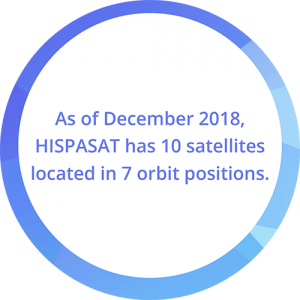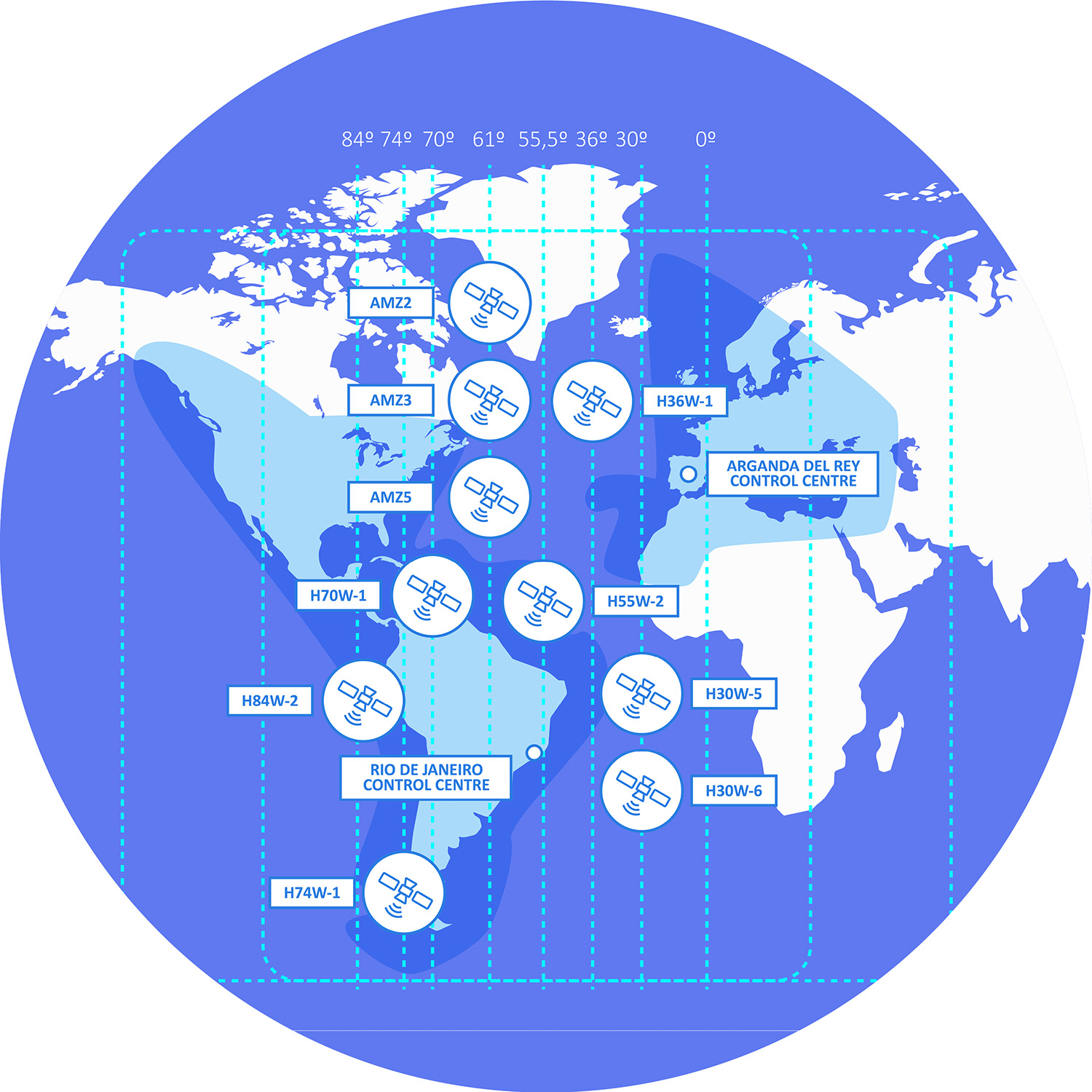SATELLITE FLEET AND CONTROL INFRASTRUCTURE
LAUNCH OF HISPASAT 30W-6
In the early morning of 5th March 2018, HISPASAT launched its new communications satellite, the Hispasat 30W-6 (H30W-6), from the Space Launch Complex 40 (SLC-40) of the Air Force Station at Cape Canaveral in Florida.
Built by Space Systems Loral in Palo Alto (California), the Hispasat 30W-6 satellite relied on significant input from Spain’s aerospace industry. The launch vehicle that was tasked with placing the H30W-6 into its transfer orbit was the Falcon 9, made by SpaceX. The satellite, located at 30º West, replaces and increases the capacity of the Hispasat 30W-4.
HISPASAT’s new satellite offers better coverage and services that increase the operator’s offering on C and Ku bands, as well as new Ka band connectivity solutions that will give rural areas access to broadband Internet. As a result, the Hispasat 30W-6 is contributing to bridging the digital divide in Latin America, Spain and North Africa. It will also strengthen the distribution of audiovisual content in Latin America and will grant connectivity to high speed train and shipping services in the Caribbean and the Mediterranean.
LANDING RIGHTS
HISPASAT holds licences or authorisations known as landing rights, whenever necessary, to operate in all those countries covered by its satellite fleet. This includes Western and Central European countries and North Africa.
Particular progress was made in 2018 to complete the landing rights for the Hispasat 74W-1, Amazonas 5 and Hispasat 30W-6 satellites.
Also during the course of this year, in addition to renewing existing licences, new authorisations or licences were obtained for the HISPASAT satellite fleet.
In parallel, and in view of the growth of current operators and the emergence of new ones, in 2018 the company intensified its analysis of documents published by the International Telecommunications Union (ITU) and its coordination activities with other operators and governments, with the aim of maintaining HISPASAT’s orbit spectrum resources.
In the same vein, the company has continuously searched for new opportunities for orbit spectrum resources, which may be useful within the framework of the company’s growth strategies.
SPACE CAPACITY OPERATIONS
SATELLITE NETWORK OPERATION CENTRES
The space capacity operation of the satellite fleet allows the allocation over time of the capacity contracted by each customer, and takes place at the Payload Monitoring Control (PMC) centres. These act as Network Operations Centres that have 24/7 customer support, manage space capacity, carrier line-up/down, signal monitoring, interference detection, peak and pol, and service problem solving.
PMC has operating centres in Arganda del Rey and in Rio de Janeiro, and remote measuring stations (CMS) on C, Ku and Ka frequency bands, which are located on the different coverage beams in Spain, Argentina, Brazil, Mexico and the United States. Likewise, it also has baseband analysis systems and tools to allocate space and transmission capacity (SIGO).
PMC has an office for Occasional Use (booking) of space capacity in order to provide these services in the short term, and to provide support for digital platform Broadband services.
PMC OPERATIONS
When the new Hispasat 30W-6 began operating in 2018, it involved the migration of certain space capacity services from the Hispasat 30W-4 satellite, which after in-orbit tests (IOT) established procedures for migrating services from one satellite to another, guaranteeing the transition without affecting supplies and avoiding interruptions, all in close coordination with the affected customers’ operating centres. In this instance it was necessary to migrate a large number of services, with a total capacity of 926 MHz, in under two weeks, and double shifts were implemented in the NOC during that period.
The carrier monitoring systems (CMS) have new stations on C, Ku and Ka bands, deployed on the new coverages, and with systems to measure additional capacity. Similarly, the first SATGUARD measuring system was installed at Arganda, in order to identify interfering VSAT terminals.
Development of the Operational Management System (SIGO) continued with a view to covering the new needs of customers arising from the services provided. Notably, customers began being provided with the online RF measuring service, and the internal operational requirements tool for commutable and/or shared transponders was implemented.
The agreements reached at the regular yearly operational meetings with customers, PMC preventive actions and customer collaboration have proved essential aids in locating and doing away with the interferences that affected the system.
Operational relationships with the satellite operators Intelsat and Telesat, which occupy the orbital positions adjacent to those occupied by the HISPASAT fleet, were strengthened with the aim of controlling adjacent satellite interference (ASI), for which operative coordination is essential, since each operator must, in a coordinated fashion, identify the stations of customers that are generating or receiving interference possibly from another satellite outside of their control.
BROADBAND OPERATIONS
The incorporation of new satellites (AMZ5, H36W-1, H30W-6) with Ka band capacities that have spot type coverage, and with Ku band with classic coverage beams, has resulted in a change to HISPASAT’s business model with the provision of what are known as Managed Services. This model had already been in use on a smaller scale in previous years. Under it, HISPASAT – as well as satellite capacity – has rolled-out Gateways on the necessary hotspots of the coverage to operate platforms or HUBs with which it can supply wholesale services to ISPs, which in turn supply Internet access services to end users, with small diameter user terminals (VSAT).
RESIDENTIAL BROADBAND
During 2018, HISPASAT applied Smart Browsing mechanisms, improving the network architecture with new equipment and establishing smart satellite broadband management solutions, in order to adapt and optimise the capacity available in the residential setting with a greater number of terminals, which generate significant demand for HUB capacity and resources.
At the same time, the HUBs were adapted for the provision of capacities on the new DVB-S2X standard, which allows for an improvement in the efficiency of the spectrum, making more capacity available to Hispasat’s broadband customers at more competitive prices. These improvements offer a very attractive solution for large Residential market customers, particularly in Mexico. Examples of this include Elara, which under the ‘México Conectado’ project has begun the roll-out of a network of 2,500 terminals, Globalsat with an agreement to deploy 550 Terminals, and Dish, whose short-term growth potential is considered to be very high.
In 2018 HISPASAT has invested heavily in this, and Gateways for managed broadband services were created in Caxias do Sul in Brazil, Ixtlahuaca in Mexico, Lurín in Peru, Bogotá in Colombia, Arica in Chile, Laredo in the USA and Arganda del Rey in Spain.
To install the Gateways composed of ground stations that can have a diameter of 13.5m, 7m or 3.8m, broadband HUBs from different manufacturers (GILAT, iDirect), IP infrastructure and high capacity INTERNET accesses, HISPASAT chose to sign agreements for the hosting of this equipment with existing telecommunications companies in the different countries, and to operate the Gateways remotely from Arganda or involve the HUB supplier/manufacturer as an operator and part of the Business model.
MOBILITY BROADBAND
In 2018 the unfolding of the network of terminals on Renfe’s high-speed trains (AVE) has been ongoing. On this, passengers are offered Internet services shared with 3G and Multicast TV, and the company has also carried out tasks to optimise some aspects of this land transport solution.
Regarding maritime mobility services, HISPASAT’s main customer in this market, Syntelix, has continued to grow, with over 100 ships deployed on the Mediterranean on the iDirect platform. Its services have also been extended to the South American coasts through a new iDirect platform installed in our partner Bansat’s ground station, broadening the provision of mobility services covered by the Hispasat 30W-6 satellite, which joined the fleet in 2018.
Lastly, the possibility of expanding mobility services to other areas not covered by the satellite fleet, using housing and satellite roaming mechanisms that employ iDirect’s “Global NMS” functionality, has been analysed. This allows for services to be expanded around the globe, using third-party satellite capacity, and with centralised operations at the Arganda Broadband NOC.
BUSINESS BROADBAND
In 2018 the business market remained stable with the networks of our main European and American customers such as Bansat, UN, Cellnex, Tesacom, Tecnoservicios, etc. It is worth highlighting the consolidation of the new Gilat platforms for Mexico and Colombia – these are based on X-Chassis architecture, which is more powerful and stable than the previous architecture, combined with new Capricorn model terminals, specially designed for the provision of business services. Similarly, through the new Gilat platform in Colombia and via a new revenue sharing business model, our customer and partner Bansat has implemented various business services with high expectations for growth.
Paseo de la Castellana, 39 28046 Madrid Spain
+34 91 710 25 40
© Informe Anual Hispasat 2018
Legal Notice
Cookies





